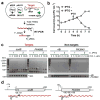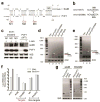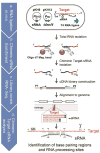GRIL-seq provides a method for identifying direct targets of bacterial small regulatory RNA by in vivo proximity ligation
- PMID: 28005055
- PMCID: PMC5567838
- DOI: 10.1038/nmicrobiol.2016.239
GRIL-seq provides a method for identifying direct targets of bacterial small regulatory RNA by in vivo proximity ligation
Abstract
The first step in the post-transcriptional regulatory function of most bacterial small non-coding RNAs (sRNAs) is base pairing with partially complementary sequences of targeted transcripts. We present a simple method for identifying sRNA targets in vivo and defining processing sites of the regulated transcripts. The technique, referred to as global small non-coding RNA target identification by ligation and sequencing (GRIL-seq), is based on preferential ligation of sRNAs to the ends of base-paired targets in bacteria co-expressing T4 RNA ligase, followed by sequencing to identify the chimaeras. In addition to the RNA chaperone Hfq, the GRIL-seq method depends on the activity of the pyrophosphorylase RppH. Using PrrF1, an iron-regulated sRNA in Pseudomonas aeruginosa, we demonstrated that direct regulatory targets of this sRNA can readily be identified. Therefore, GRIL-seq represents a powerful tool not only for identifying direct targets of sRNAs in a variety of environments, but also for uncovering novel roles for sRNAs and their targets in complex regulatory networks.
Conflict of interest statement
The authors declare no conflict of interest.
Figures





Similar articles
-
Toward a Comprehensive Analysis of Posttranscriptional Regulatory Networks: a New Tool for the Identification of Small RNA Regulators of Specific mRNAs.mBio. 2021 Feb 23;12(1):e03608-20. doi: 10.1128/mBio.03608-20. mBio. 2021. PMID: 33622723 Free PMC article.
-
Mapping the small RNA interactome in bacteria using RIL-seq.Nat Protoc. 2018 Jan;13(1):1-33. doi: 10.1038/nprot.2017.115. Epub 2017 Dec 7. Nat Protoc. 2018. PMID: 29215635
-
Conditional Hfq Association with Small Noncoding RNAs in Pseudomonas aeruginosa Revealed through Comparative UV Cross-Linking Immunoprecipitation Followed by High-Throughput Sequencing.mSystems. 2019 Dec 3;4(6):e00590-19. doi: 10.1128/mSystems.00590-19. mSystems. 2019. PMID: 31796567 Free PMC article.
-
Target activation by regulatory RNAs in bacteria.FEMS Microbiol Rev. 2015 May;39(3):362-78. doi: 10.1093/femsre/fuv016. Epub 2015 Apr 30. FEMS Microbiol Rev. 2015. PMID: 25934124 Free PMC article. Review.
-
How to find small non-coding RNAs in bacteria.Biol Chem. 2005 Dec;386(12):1219-38. doi: 10.1515/BC.2005.140. Biol Chem. 2005. PMID: 16336117 Review.
Cited by
-
Contrasting silencing mechanisms of the same target mRNA by two regulatory RNAs in Escherichia coli.Nucleic Acids Res. 2018 Mar 16;46(5):2600-2612. doi: 10.1093/nar/gkx1287. Nucleic Acids Res. 2018. PMID: 29294085 Free PMC article.
-
GNNs and ensemble models enhance the prediction of new sRNA-mRNA interactions in unseen conditions.BMC Bioinformatics. 2025 May 21;26(1):131. doi: 10.1186/s12859-025-06153-w. BMC Bioinformatics. 2025. PMID: 40399818 Free PMC article.
-
The RNA-RNA interactome between a phage and its satellite virus reveals a small RNA that differentially regulates gene expression across both genomes.Mol Microbiol. 2023 Apr;119(4):515-533. doi: 10.1111/mmi.15046. Epub 2023 Feb 27. Mol Microbiol. 2023. PMID: 36786209 Free PMC article.
-
Agnodice: indexing experimentally supported bacterial sRNA-RNA interactions.mBio. 2024 Mar 13;15(3):e0301023. doi: 10.1128/mbio.03010-23. Epub 2024 Feb 6. mBio. 2024. PMID: 38319109 Free PMC article.
-
Global analysis of the RNA-RNA interactome in Acinetobacter baumannii AB5075 uncovers a small regulatory RNA repressing the virulence-related outer membrane protein CarO.Nucleic Acids Res. 2024 Oct 14;52(18):11283-11300. doi: 10.1093/nar/gkae668. Nucleic Acids Res. 2024. PMID: 39149883 Free PMC article.
References
Grants and funding
LinkOut - more resources
Full Text Sources
Other Literature Sources

